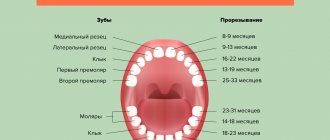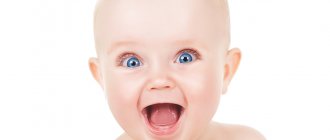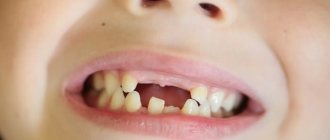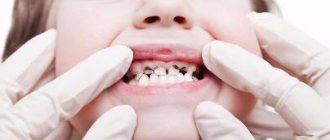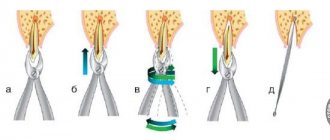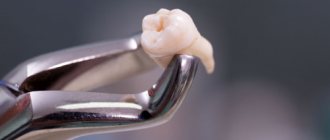How many teeth should a child have?
By the age of three, a child usually already has a full set of twenty primary teeth, and until about 6 years old, their number remains unchanged. Adolescents aged 13 to 18 years should normally have from 28 to 32 molars (depending on the presence of eights, which may erupt after 21 years or not appear at all).
Changing baby teeth to molars
Around the age of 4, a child’s growth spurt begins, the jaws enlarge and the baby teeth seem to move apart, with gaps appearing between them – trema. If this does not happen and by the age of 5 the teeth are still tight, you need to show the child to the dentist, as there may not be enough space for permanent teeth.
At about 5-6 years of age, baby teeth begin to become loose and gradually fall out, which indicates that the molars are already beginning to grow underneath them. Usually this process of change lasts for 5-8 years and the final formation of the dentition occurs somewhere around 14-15 years.
This happens in the following order:
- 5-6 years – lower and upper incisors.
- 7-8 years – lower and upper lateral incisors.
- 8-10 years – upper and lower molars.
- 9-11 years – upper and lower canines.
- 11-13 years – upper and lower molars.
Milk teeth are replaced by permanent molars. Their number at the age of 14-16 years is 28. At the same time, the third molars (wisdom teeth) are already formed, but they begin to grow only after 18 years. True, not all people grow them. It all depends on individual characteristics.
What teeth appear first in children?
The rudiments of baby teeth and even some molars begin to form at the stage of intrauterine development, so modern diagnostic technologies make it possible to track this process and prevent some deviations. After birth, the first teeth usually begin to erupt when the baby reaches six months of age. This means he will soon be ready to eat more solid foods. In the vast majority of cases, the incisors appear first: as a rule, the lower central incisor becomes the “pioneer”.
Main means and rules of care
A toothbrush and toothpaste are the main tools for caring for a child’s oral cavity. They should be chosen with great care.
How to choose a toothbrush
A common mistake is choosing a brush with too stiff bristles. Do not buy these so as not to injure the delicate gums and developing enamel of the child’s teeth. The bristles should be soft or medium soft, the brush head should be small. It would be good if the brush had a non-slip handle. Be sure to teach your child the correct cleaning technique - the movements should be sweeping, from top to bottom on the upper jaw and from bottom to top on the lower jaw. Movements from left to right not only leave uncleaned plaque on the teeth, but also damage the enamel.
A manual brush cleans plaque no worse than an electric one, but only if the cleaning technique is perfect. In addition, electric brushes, due to their bright design and unusual design, are more popular with children; with their help, it is easier to instill a love for oral hygiene. Remember that until around age 11, when your child's motor skills are fully developed, you still need to supervise his brushing.
How to choose toothpaste
Buy pastes containing strengthening components: hydroxyapatite, calcium or fluorine. They will help strengthen the enamel and prevent the development of caries. The optimal concentration of fluorides in the paste is up to 900 ppm (that is, 900 parts per million). Pastes with higher concentrations are used only in courses and as prescribed by a doctor. Remineralizing gels will provide excellent additional protection against caries.
Biorepair Junior toothpaste with mint flavor (from 6 to 12 years)
Tooth gel GC Tooth Mousse Multifruit
Gel for strengthening teeth ROCS (ROCS) Medical Minerals with fruit flavor…
Do not buy toothpastes with a high index of abrasiveness (RDA) - they polish and brighten teeth, but can damage the enamel. Pastes with an abrasiveness of up to 50 RDA are suitable for teenagers; this is enough for gentle cleansing. For whitening, it is better to choose toothpastes with natural enzymes (bromelain and papain). Pastes should not contain parabens or foaming agents (SLS, SLES).
Additional tools
Additional, but no less important components of care are dental floss and an irrigator (its use is mandatory if the child wears braces). With the help of these tools, the child will be able to thoroughly clean the interdental spaces that no brush can handle, even with the perfect cleaning technique. It is also a good idea to use rinses or special foams. They are convenient to use when it is not possible to brush your teeth, for example, at school or while traveling.
The natural sweetener xylitol will be a good helper in caring for your child’s teeth. It is added not only to candies and chewing gum, which can usefully replace regular ones, but also to toothpastes. The xylitol in their composition helps fight cariogenic bacteria and also takes care of the gums.
Chewing gum miradent Xylitol For Kids apple
Lollipops miradent Xylitol Drops mint
Chewing gum The Humble Co. Tropical Fruits
Fuzzy Rock Xylitol Crystals, Sugar Free, Peach Flavor
Child's front teeth
Since a child’s front teeth usually erupt earlier than the rest, they can be used to track how the baby’s body tolerates this process. It can occur in different ways: some children are practically not worried, while others, on the contrary, experience stress and discomfort. Swelling of the gums at the site of the future tooth, itching and pain, as well as a slight increase in temperature are the main negative aspects associated with the appearance of the first teeth. When teething baby molars, children may experience runny nose and cough.
Time of start of eruption
The appearance of the first tooth is a holiday for the whole family, but only a loving mother and an attentive father know how much anxiety and worries are associated with this event. A couple of days, or even weeks, before the first external signs of teething appear, children cry, are capricious, and lose their appetite. Moms are having a hard time—sleepless nights.
The central tooth below can grow even at eleven months. The timing of teething is individual for each baby. For almost all babies, only the symptoms of a tooth appearing remain the same. And even a professional doctor cannot determine exactly how many months the process of jaw formation will begin.
How do children's teeth grow?
There is no need to panic if the child’s teeth growth does not fit into the above scheme. A delay of 1 - 3 months is considered normal and is associated with the individual characteristics of the body. Children under one year of age often have teeth that do not appear on schedule or may not appear at all. In the latter case, you need to contact your dentist who will help identify the cause.
How to help your baby?
Initially, the dentist will take an X-ray of the baby's jaw to make sure that the baby has the rudiments of teeth inside. If there is, then eruption will happen soon. At first, the gums will swell a little and salivation will become very abundant: these are the main symptoms of the rapid appearance of teeth. You can help them a little:
- Teether toys are an excellent device for training gums; they help relieve severe itching and reduce pain.
- Mothers should learn how to gently massage their baby’s gums. It is better to massage with a clean finger lubricated with a special gel for children's gums.
- It is important to add healthy purees and healthy foods to your baby’s diet that will help the child’s body receive the necessary microelements and vitamins.
If the baby generally develops within normal limits, eats well, sleeps, is active and cheerful, then the absence of teeth at 1 year is definitely not a reason to panic. Each child develops at his own pace. In general, boys tend to lag slightly behind girls in some physiological parameters.
From this article it follows that you should not worry unnecessarily! If in any doubt, seek advice from a pediatric dentist at our Babydent
Show more tips
Tooth growth abnormalities in children
Unfortunately, the development and growth of teeth in children does not always occur as expected: there are a number of anomalies of various types that in one way or another affect the aesthetics and/or functionality of the teeth.
Causes of impaired growth and development of teeth:
- bad heredity;
- fetal injury during pregnancy or birth; intrauterine growth retardation, infections and so on;
- disruption of the endocrine system, thyroid dysfunction;
- lack of vitamins and minerals;
- mechanical, thermal and chemical injuries to teeth;
- bad habits in children that can affect the formation of teeth;
- lack of proper hygiene and poor diet.
Below is a table that describes the most common types of dental anomalies in children.
| Anomaly class | Description |
| Size of teeth | There are microdentia (too small teeth) and macrodentia (too large teeth). The anomaly can affect one or several teeth (and even the entire dentition). |
| Number of teeth | There is partial (lack of several teeth) and complete (absence of all teeth) adentia. Hyperdentia is a supernumerary set of teeth (usually in the second row). |
| Shape of teeth | Cone-shaped, barrel-shaped (Hutchinson's teeth), Pflueger's teeth (the neck is more developed than the coronal part). |
| Anomalies in the structure of enamel and dentin | Hypoplasia (spots and grooves on the body of the tooth), hyperplasia (tubercles, enamel drops, etc.), dentinogenesis imperfecta (violation of the structure and color of dentin). |
| Color irregularities | Enamel pigmentation (gray, black, amber enamel color). Most often it is caused by a disruption of the immune system during the prenatal stage of development. |
| Malocclusion | All types of dental malocclusions: mesial, cross, open, deep and so on. |
Despite the fact that some dental anomalies in children are quite serious, a timely visit to the dentist will help you avoid problems and maintain the health and beauty of your smile. If you let the situation take its course, unpleasant consequences will not keep you waiting.
Children's dentition and everything about it
All parents carefully search for information about the correct number of teeth in the baby’s mouth in relation to his age. They are often interested in shape and size. It is worth remembering that the information received should not exempt the child from visiting the dentist for preventive purposes. Sometimes there may be congenital manifestations of anomalies in the oral cavity. We are talking about defects in the growth of teeth, as well as their incomplete composition in the upper or lower jaw.
Directly, baby teeth do not remain in the oral cavity throughout life, but only for a limited time, after which they fall out. After them, permanent ones grow up, which stay with the person for life, provided they are treated with care. Primary and permanent teeth have a number of differences, namely:
- The incisors of baby teeth have a more convex shape.
- Permanent teeth have a more developed root system than baby teeth, which fall out without causing discomfort.
- The enamel of primary teeth is thinner, but their pulp capsule is more pronounced. Baby teeth are more susceptible to caries.
The first teeth begin to appear at 4-5 months, but a delay of six months is not a violation. There is a certain sequence in which a baby’s first teeth appear:
- Incisors: central ones appear from 4 to 9 months, and lateral ones are expected from 8 months to 12 months.
- The first molars appear after the child is one year old.
- Clicks are expected from 1 to 2 years.
- By the age of 3, the second molars begin to emerge.
It is worth noting that at the age of three, a baby already has about 20 teeth in his mouth. Then, in their further growth, a pause is expected until the child reaches 5 or 6 years of age.
Baby oral care
The need to take care of the oral cavity appears from the moment the child’s first teeth come out. Sufficient attention to oral hygiene will help prevent the development of many dental pathologies.
Prevention of dental diseases includes:
- Daily brushing of teeth. Until the age of one, experts recommend using a silicone toothbrush to clean the entire oral cavity. Parents should brush the teeth of a child under 4 years old, and children from four to eight years old should do the procedure independently under adult supervision.
- Rinsing your mouth after eating.
- Compliance with diet. The child's diet should include foods containing calcium, fluoride and other microelements. Until the age of one and a half years, it is undesirable for a child to consume chocolate or confectionery sweets, and snacks between meals are also undesirable.
Regardless of how many teeth your baby has lost by 8, 9, or 12 months, at the age of one year you should take him to a dentist for an oral examination.


